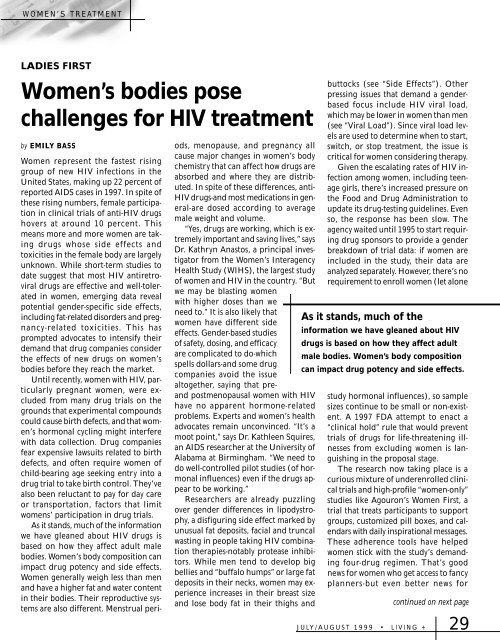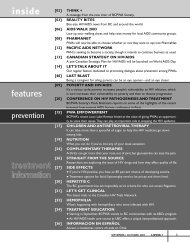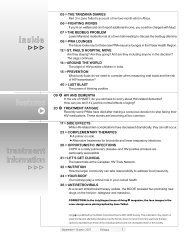Living + Magazine Issue 1 - Positive Living BC
Living + Magazine Issue 1 - Positive Living BC
Living + Magazine Issue 1 - Positive Living BC
You also want an ePaper? Increase the reach of your titles
YUMPU automatically turns print PDFs into web optimized ePapers that Google loves.
WOMEN’S TREATMENT<br />
LADIES FIRST<br />
Women’s bodies pose<br />
challenges for HIV treatment<br />
by EMILY BASS<br />
Women represent the fastest rising<br />
group of new HIV infections in the<br />
United States, making up 22 percent of<br />
reported AIDS cases in 1997. In spite of<br />
these rising numbers, female participation<br />
in clinical trials of anti-HIV drugs<br />
hovers at around 10 percent. This<br />
means more and more women are taking<br />
drugs whose side effects and<br />
toxicities in the female body are largely<br />
unknown. While short-term studies to<br />
date suggest that most HIV antiretroviral<br />
drugs are effective and well-tolerated<br />
in women, emerging data reveal<br />
potential gender-specific side effects,<br />
including fat-related disorders and pregnancy-related<br />
toxicities. This has<br />
prompted advocates to intensify their<br />
demand that drug companies consider<br />
the effects of new drugs on women’s<br />
bodies before they reach the market.<br />
Until recently, women with HIV, particularly<br />
pregnant women, were excluded<br />
from many drug trials on the<br />
grounds that experimental compounds<br />
could cause birth defects, and that women’s<br />
hormonal cycling might interfere<br />
with data collection. Drug companies<br />
fear expensive lawsuits related to birth<br />
defects, and often require women of<br />
child-bearing age seeking entry into a<br />
drug trial to take birth control. They’ve<br />
also been reluctant to pay for day care<br />
or transportation, factors that limit<br />
womens’ participation in drug trials.<br />
As it stands, much of the information<br />
we have gleaned about HIV drugs is<br />
based on how they affect adult male<br />
bodies. Women’s body composition can<br />
impact drug potency and side effects.<br />
Women generally weigh less than men<br />
and have a higher fat and water content<br />
in their bodies. Their reproductive systems<br />
are also different. Menstrual peri-<br />
ods, menopause, and pregnancy all<br />
cause major changes in women’s body<br />
chemistry that can affect how drugs are<br />
absorbed and where they are distributed.<br />
In spite of these differences, anti-<br />
HIV drugs-and most medications in general-are<br />
dosed according to average<br />
male weight and volume.<br />
“Yes, drugs are working, which is extremely<br />
important and saving lives,” says<br />
Dr. Kathryn Anastos, a principal investigator<br />
from the Women’s Interagency<br />
Health Study (WIHS), the largest study<br />
of women and HIV in the country. “But<br />
we may be blasting women<br />
with higher doses than we<br />
need to.” It is also likely that<br />
women have different side<br />
effects. Gender-based studies<br />
of safety, dosing, and efficacy<br />
are complicated to do-which<br />
spells dollars-and some drug<br />
companies avoid the issue<br />
altogether, saying that preand<br />
postmenopausal women with HIV<br />
have no apparent hormone-related<br />
problems. Experts and women’s health<br />
advocates remain unconvinced. “It’s a<br />
moot point,” says Dr. Kathleen Squires,<br />
an AIDS researcher at the University of<br />
Alabama at Birmingham. “We need to<br />
do well-controlled pilot studies (of hormonal<br />
influences) even if the drugs appear<br />
to be working.”<br />
Researchers are already puzzling<br />
over gender differences in lipodystrophy,<br />
a disfiguring side effect marked by<br />
unusual fat deposits, facial and truncal<br />
wasting in people taking HIV combination<br />
therapies-notably protease inhibitors.<br />
While men tend to develop big<br />
bellies and “buffalo humps” or large fat<br />
deposits in their necks, women may experience<br />
increases in their breast size<br />
and lose body fat in their thighs and<br />
buttocks (see “Side Effects”). Other<br />
pressing issues that demand a genderbased<br />
focus include HIV viral load,<br />
which may be lower in women than men<br />
(see “Viral Load”). Since viral load levels<br />
are used to determine when to start,<br />
switch, or stop treatment, the issue is<br />
critical for women considering therapy.<br />
Given the escalating rates of HIV infection<br />
among women, including teenage<br />
girls, there’s increased pressure on<br />
the Food and Drug Administration to<br />
update its drug-testing guidelines. Even<br />
so, the response has been slow. The<br />
agency waited until 1995 to start requiring<br />
drug sponsors to provide a gender<br />
breakdown of trial data: if women are<br />
included in the study, their data are<br />
analyzed separately. However, there’s no<br />
requirement to enroll women (let alone<br />
As it stands, much of the<br />
information we have gleaned about HIV<br />
drugs is based on how they affect adult<br />
male bodies. Women’s body composition<br />
can impact drug potency and side effects.<br />
study hormonal influences), so sample<br />
sizes continue to be small or non-existent.<br />
A 1997 FDA attempt to enact a<br />
“clinical hold” rule that would prevent<br />
trials of drugs for life-threatening illnesses<br />
from excluding women is languishing<br />
in the proposal stage.<br />
The research now taking place is a<br />
curious mixture of underenrolled clinical<br />
trials and high-profile “women-only”<br />
studies like Agouron’s Women First, a<br />
trial that treats participants to support<br />
groups, customized pill boxes, and calendars<br />
with daily inspirational messages.<br />
These adherence tools have helped<br />
women stick with the study’s demanding<br />
four-drug regimen. That’s good<br />
news for women who get access to fancy<br />
planners-but even better news for<br />
continued on next page<br />
JULY/AUGUST 1999 • LIVING + 29











